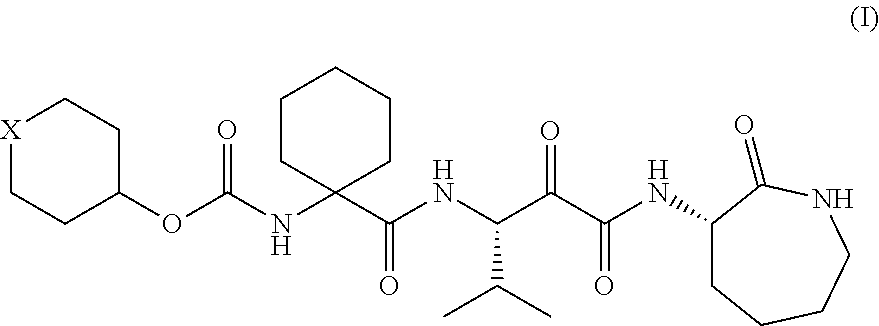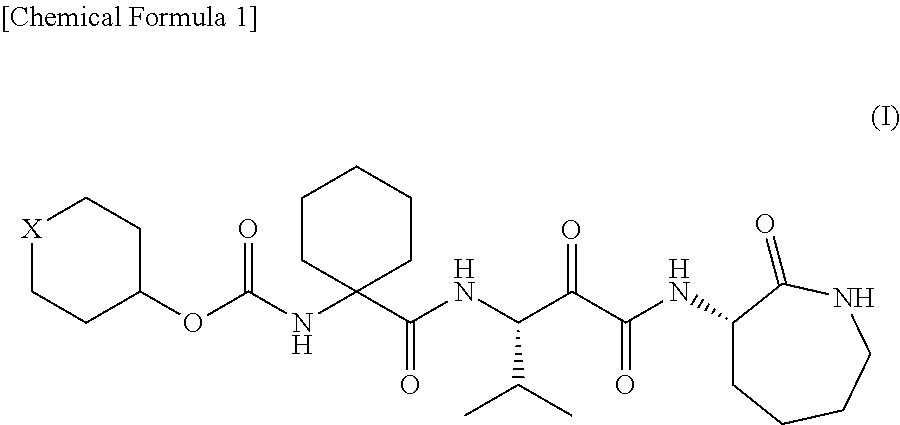Alpha-oxoacyl amino-caprolactam derivative
a technology of oxoacyl and amino-caprolactam, which is applied in the field of new oxoacyl amino-caprolactam derivatives, can solve the problems of high cyp3a4 inhibitory activity and have not been put into practical use, and achieves low cyp3a4 inhibitory activity, substantial bone resorption, and high cathepsin k inhibitory activity.
- Summary
- Abstract
- Description
- Claims
- Application Information
AI Technical Summary
Benefits of technology
Problems solved by technology
Method used
Image
Examples
production example 1
Production of 1-[[[(tetrahydro-2H-pyran-4-yl)oxy]carbonyl]amino]cyclohexanecarboxylic acid
[0171]
(1) Production of 1-[[[(tetrahydro-2H-pyran-4-yl)oxy]carbonyl]amino]cyclohexanecarboxylic acid benzyl ester
[0172]
[0173]Benzyl 1-aminocyclohexanecarboxylate (11.1 g, 50 mmol) was added to a dichloromethane solution of di-tert-butyl dicarbonate (10.9 g, 50 mmol) and 4-dimethylaminopyridine (622 mg, 5 mmol) and stirred at room temperature for 30 minutes. The reaction mixture was concentrated in vacuo. Tetrahydro-4-pyranol (6.13 g, 60 mmol) and N,N-diisopropylethylamine (7.75 g, 60 mmol) were added to the residue and stirred at 100° C. for 12 hours. The reaction mixture was returned to room temperature and diluted with 20% ethyl acetate / hexane. The dilution was then washed once with a 10% potassium hydrogen sulfate aqueous solution and twice with water. After the organic layer was dried over anhydrous sodium sulfate, the solvent was removed by distillation in vacuo, so that 15.87 g (88%) of t...
production example 2
Production of (2R,3S)-3-amino-N-[(3S)-hexahydro-2-oxo-1H-azepin-3-yl]-2-hydroxy-4-methylpentanamide and (2S,3S)-3-amino-N-[(3S)-hexahydro-2-oxo-1H-azepin-3-yl]-2-hydroxy-4-methylpentanamide
[0178]
(1) Production of Boc-L-valinal
[0179]
[0180]Di-tert-butyl dicarbonate (211.6 g, 0.97 mol) was gradually added to a dichloromethane solution of L-valinol (100.0 g, 0.97 mol). The reaction mixture was stirred at room temperature overnight and then concentrated in vacuo. To the residue (crude Boc-L-valinol) were added N,N-diisopropylethylamine (51.7 g, 0.4 mol), 1 L of dry dimethyl sulfoxide, and 200 ml of dry dichloromethane. Under ice cooling, sulfur trioxide-pyridine (63.7 g, 0.4 mol) was gradually added to the liquid mixture and stirred at the same temperature for 1 hour. The reaction mixture was poured into ice-water and then extracted twice with ethyl acetate. The organic layer was washed with a 20% citric acid aqueous solution, a saturated sodium hydrogen carbonate aqueous solution, and b...
production example 3
Production of [1-[[[(1S,2R)-3-[[(3S)-hexahydro-2-oxo-1H-azepin-3-yl]amino]-2-hydroxy-1-(1-methylethyl)-3-oxopropyl]amino]carbonyl]cyclohexyl]carbamic acid tetrahydro-2H-pyran-4-yl ester
[0195]
[0196]Under ice cooling, 1-ethyl-3-(3-dimethylaminopropyl)carbodiimide hydrochloride (49.2 g, 257 mmol) was added to a dichloromethane solution of 1-[[[(tetrahydro-2H-pyran-4-yl)oxy]carbonyl]amino]cyclohexanecarboxylic acid (63.3 g, 233 mmol), (2R,3S)-3-amino-N-[(3S)-hexahydro-2-oxo-1H-azepin-3-yl]-2-hydroxy-4-methylpentanamide (60.0 g, 233 mmol), 1-hydroxybenzotriazole (35.7 g, 245 mmol), and triethylamine (28.3 g, 280 mmol). The liquid mixture was returned to room temperature and stirred overnight. The reaction mixture was diluted with dichloromethane. The dilution was washed with a 10% potassium hydrogen sulfate aqueous solution, a saturated sodium hydrogen carbonate aqueous solution, and brine. After the organic layer was dried over anhydrous sodium sulfate, the solvent was removed by distil...
PUM
| Property | Measurement | Unit |
|---|---|---|
| temperature | aaaaa | aaaaa |
| temperature | aaaaa | aaaaa |
| temperature | aaaaa | aaaaa |
Abstract
Description
Claims
Application Information
 Login to View More
Login to View More - R&D
- Intellectual Property
- Life Sciences
- Materials
- Tech Scout
- Unparalleled Data Quality
- Higher Quality Content
- 60% Fewer Hallucinations
Browse by: Latest US Patents, China's latest patents, Technical Efficacy Thesaurus, Application Domain, Technology Topic, Popular Technical Reports.
© 2025 PatSnap. All rights reserved.Legal|Privacy policy|Modern Slavery Act Transparency Statement|Sitemap|About US| Contact US: help@patsnap.com



